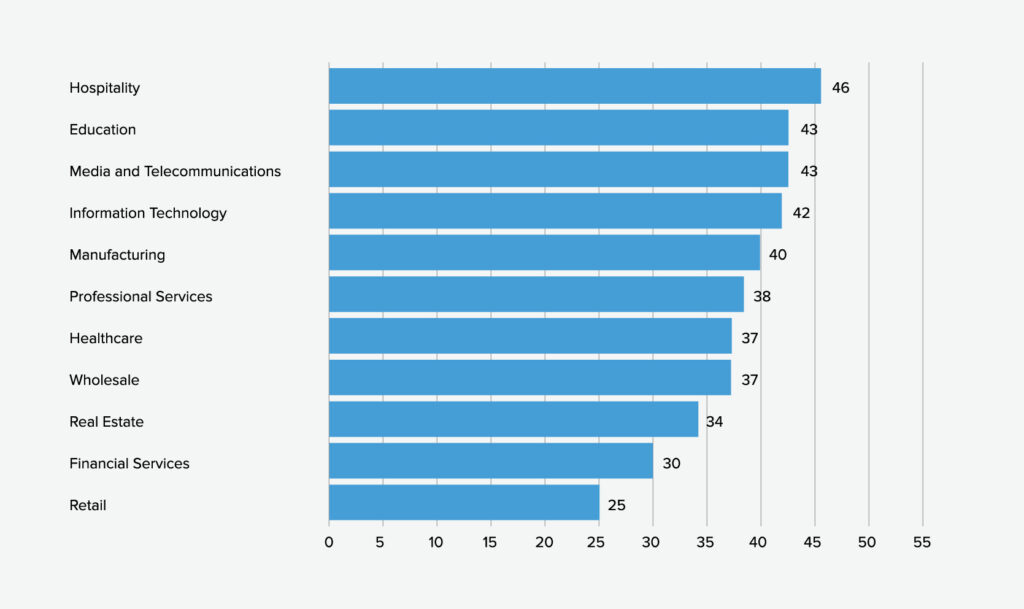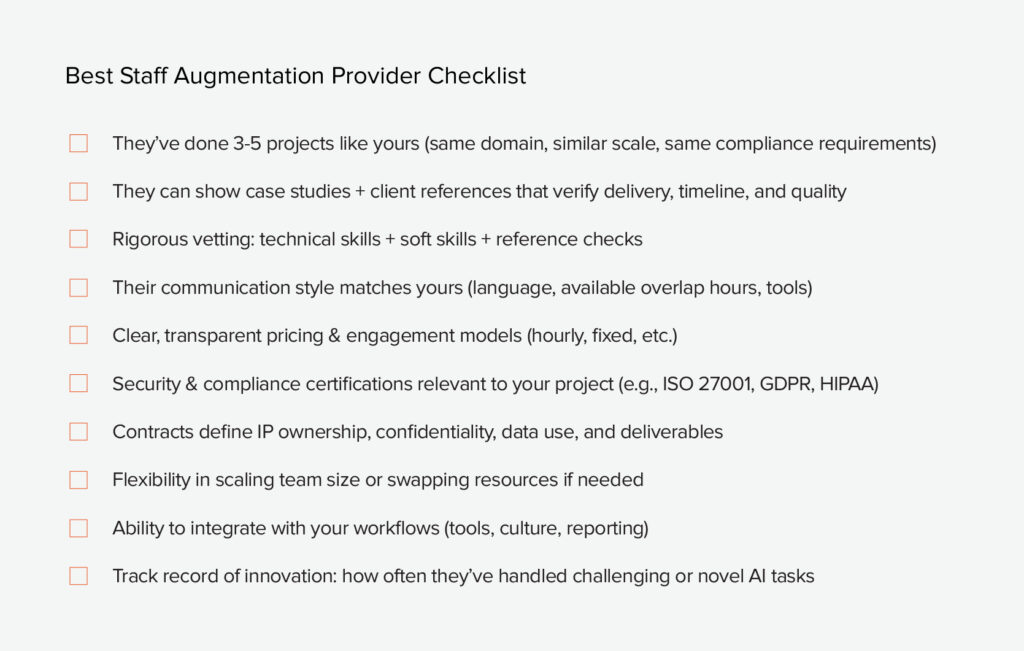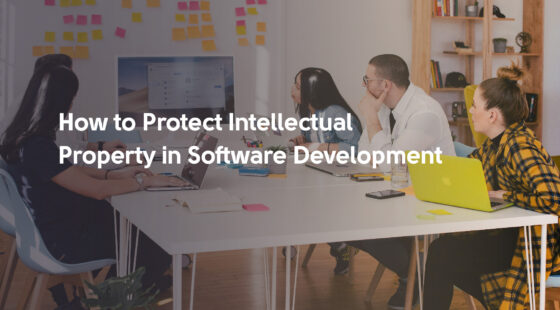The demand for artificial intelligence (AI) and machine learning (ML) talent is exploding. Just think of this mind-blowing stat:
- AI job postings have surged by more than 70% in recent years, according to McKinsey.
- The world faces a projected shortage of 85.2 million skilled workers by 2030.
No wonder businesses are struggling to find the right experts without overspending. That’s why more companies are turning to AI staff augmentation—a flexible, cost-effective way to bring in AI/ML specialists on demand without the delays and costs of traditional hiring.
Still in doubt whether your AI project needs staff augmentation services? We’ve compiled an ultimate guide for you covering benefits, best practices, and the top companies for staff augmentation in AI and machine learning in 2025.
Understanding AI Staff Augmentation
Think of AI staff augmentation as a shortcut to getting the talent you need, exactly when you need it. Instead of building entire teams, companies can quickly access roles like data scientists, ML engineers, or NLP specialists to speed up development. What does this look like in practice? According to McKinsey, over half of companies are already tapping into external talent for their AI projects.
Without integrating external experts, this is what the average time to hire looks like today by industry:

Average time-to-hire in days
Source: techvify.com
However, there’s a difference between AI staff augmentation and traditional outsourcing. Here’s a simple explanation for it:
- With AI staff augmentation, outside experts work with your team, under your direction.
- With outsourcing, you hand the project over and let the vendor run it.
| AI Staff Augmentation | Traditional Outsourcing | |
| Control | The company keeps ownership | The vendor runs the whole project |
| Integration | External experts join internal teams | Vendor works separately |
| Flexibility | Scaling talent up or down is quick and easy | A less agile, contract-based collaboration model |
| Focus | Fills specific AI/ML skill gaps | Entire projects offloaded |
| Cost | Paying only for needed expertise | Often bundled, less transparent |
With the global AI talent shortage, companies use AI staff augmentation to:
- Access niche skills (e.g., NLP, computer vision, data engineering)
- Shorten hiring cycles
- Scale teams flexibly
- Speed up AI initiatives without inflating payroll.
| Interesting fact: 64% of IT leaders say talent shortages are the top barrier to adopting emerging technologies like AI. |
Why Businesses Need AI and Data-Driven Staff Augmentation
Right now, businesses worldwide are feeling the pressure. AI talent is limited, and the gap between demand and supply is growing rapidly. A recent Stanford-backed report shows that in the U.S. alone, the share of AI-related job posts increased by nearly 29% in 2024—and the total AI postings doubled from 40,000 to 80,000 in just one year. Reasons? Education and training simply can’t keep pace with how quickly the field is changing.
Globally, the situation is even more critical: IDC predicts that by 2026, over 90% of enterprise leaders will face severe AI skills shortages, potentially costing the economy $5.5 trillion in lost performance.
This gap doesn’t just slow down hiring; it threatens innovation itself. That’s why more companies are turning to AI and data-driven staff augmentation as a practical solution. It enables them to:
- Expand teams rapidly with AI specialists (data engineers, ML architects, or NLP experts) exactly when needed, without the delays of full-time hiring
- Respond to changing project demands or deadlines without major disruptions
- Bring in new skills and outside perspectives that generate fresh ideas and accelerate execution
- Avoid lengthy recruitment processes and manage costs by paying only for the expertise needed.
AI Staff Augmentation for Enterprises vs. Startups
AI staff augmentation benefits both established enterprises and small startups equally. For large organizations, it bridges skill gaps and speeds up digital transformation without interfering with current workflows. For startups, it offers access to top-tier expertise and technical talent precisely when needed without the costs of permanent hiring.
| Enterprises | Startups | |
| Strategy & Leadership | AI roadmaps, readiness audits, and fractional AI leadership to guide adoption. | Fractional CTO/AI leaders to shape product direction and support fundraising. |
| Early Validation | Discovery workshops and PoCs (Proof of Concept) to test data, models, and feasibility. | Rapid PoCs to validate ideas and attract investors. |
| MVP Development & Deployment | MVPs are integrated into enterprise systems and workflows. | MVPs are built fast to reach the market and scale quickly. |
| Process & Workflow Automation | Modernizing RPA, automating workflows, and boosting efficiency. | Adding automation to enhance product usability or backend processes. |
| Team Expansion | On-demand AI/ML talent to scale internal teams. | Flexible tech talent for MVP builds and scaling needs. |
| Key Use Cases | Predictive maintenance Risk modeling GenAI copilots Computer vision Document intelligence | Recommendation engines Vision-based features Semantic search Generative interfaces |
Key Benefits of AI Staff Augmentation Services
Hiring AI talent is challenging, slow, and costly, and when deadlines are tight, that’s the last thing you need. AI staff augmentation addresses this issue by providing you with on-demand access to skilled specialists without the lengthy hiring process. Here’s what makes this approach so effective:

Cost Efficiency You Can Measure
Instead of pouring money into recruitment, onboarding, and training, companies can hire experts only for the time they’re needed. This approach can reduce operational costs by 25–40% and speed up project timelines by around 20%.
Scalability Without Hiring Headaches
AI projects often have fluctuating needs, from quick data prep sprints to large-scale ML deployments. Staff augmentation lets businesses scale teams up or down immediately, without committing to long-term hires or dealing with layoffs when demand drops.
Access to Specialized Expertise
Some AI skills, like neural network design or fraud detection modeling, are hard to find and even harder to keep in-house. Staff augmentation taps into a global talent pool, giving you access to niche expertise and speeding up innovation. Studies show internal teams adopt new tech 35–40% faster when working alongside experienced specialists.
Lower Risk, Faster Time-to-Market
Hiring full-time employees for every AI role takes months and still risks poor hires. Augmented teams are pre-vetted and ready to work immediately, helping companies reduce delivery time by up to 20% and faster deploy AI features or products into production.
Best Practices for Successful AI Staff Augmentation
Getting outside AI/ML talent is only part of the equation. What separates successful projects from troubled ones is making it work smoothly with your internal processes, culture, and risk profile. Below are the best practices to support seamless integration, clear accountability, and effective risk management.
Essential Best Practices for AI Staff Augmentation
From the many approaches to successfully implementing AI staff augmentation, we’ve compiled a definitive list of the best, proven tips that will benefit any business.
Clear Definition of Roles and Responsibilities
Before bringing augmented staff onboard, clearly define who does what. Outline roles, responsibilities, reporting lines, and what “done” looks like. Using a RACI chart (Responsible, Accountable, Consulted, Informed) helps prevent overlap, confusion, and duplicated effort. Unclear roles are one of the main reasons projects fail to meet their goals.
Integration with In-House Teams
Treat augmented talent not as outsiders, but as part of the team. Include them in sprint planning, daily stand-ups, and regular team rituals. Give them access to the same tools, documentation, and context your internal staff uses. This helps align culture and expectations while reducing friction.
Communication Frameworks and Agile Methodologies
Consistent, transparent communication is essential, especially when teams are partly remote or distributed. Use agile ceremonies, like sprint reviews and retrospectives, clearly defined milestones, and shared tools (Slack, Teams, Asana, Jira) to ensure everyone stays aligned. Feedback loops are crucial for identifying issues early.
Ensuring Data Security & Compliance
Augmented staff often have access to sensitive data, such as customer information, internal IP, or regulated details. To reduce risk, implement strong NDAs, role-based access controls, MFA, secure communication channels, and regular audits. Ensure all external individuals are aware of and follow your industry’s regulatory standards (e.g., GDPR, HIPAA).
Measuring Performance and ROI
You can’t improve what you don’t measure. Establish both quantitative and qualitative KPIs upfront, such as delivery timelines, code quality, bug rates, stakeholder satisfaction, or model performance. Use dashboards, regular reviews, and feedback sessions to monitor how augmented staff are progressing and identify where adjustments are needed.
Tips for Seamless Integration and Risk Management
Even with clear roles, strong communication, and well-defined processes, challenges are inevitable when expanding your team. The good news is that most risks can be anticipated and addressed with proper planning. Here’s how to ensure your augmented AI team is productive, aligned, and secure from day one:
Onboarding & Knowledge Transfer
Treat onboarding seriously to minimize downtime.
- Share a clear onboarding checklist and access to documentation, code standards, and project goals.
- Provide a central knowledge hub (Confluence, Notion) and pair each new member with an internal mentor.
- Set up collaboration tools (Slack, GitHub, Asana) before their first day so they can contribute immediately.
Cultural Fit
Alignment matters no less than good technical skills.
- Screen for communication style and collaboration habits, not just hard skills.
- Share company values and norms early and include augmented staff in sprint planning and retros.
- Build trust by treating them like part of the core team.
IP Protection and Data Security
AI projects handle sensitive data, so security must be proactive.
- Use NDAs and clear contracts defining IP ownership.
- Grant role-based access and require secure channels (VPN, MFA) for collaboration.
- Monitor contributions with code reviews and version control.
Distributed Team Coordination
Time zones don’t have to slow you down.
- Align overlap hours for live discussions and use async-friendly practices like recorded updates and shared notes.
- Keep everyone synced with visible project boards (Jira, Trello) and weekly demos or reviews.
Best Firms for Outsourcing AI Projects with Staff Augmentation Support: How to Choose One
Here we reach the most important stage. When outsourcing a project with AI staff augmentation, success heavily depends on selecting the right business partner. Below are the criteria to consider, how to evaluate providers, and a checklist to help make the process systematic and low-risk.
Key Criteria for Choosing the Best Firms
To make sure the business partner you select for staff augmentation is the best fit for your project, evaluate them based on these criteria.
- Proven AI / ML Expertise
Check their technical depth: do they have experience in machine learning, NLP, computer vision, model deployment, MLOps, etc. Industry-specific experience helps, because firms that have worked in regulated sectors (finance, healthcare) are likely to better understand compliance and domain constraints.
- Strong Talent Pool & Screening Process
How rigorously do they screen? Look for coding tests, soft-skills evaluation, interviews, reference checks. Also, global reach or geographic diversity is a plus: access to specialists in under-supplied areas.
- Cultural & Communication Fit
Ability to integrate with your in-house team’s way of working: language fluency, overlap in working hours, communication norms, responsiveness, shared values, or at least an understanding of your values, etc.
- Security & Compliance
Certifications and compliance with data protection rules (GDPR, HIPAA, ISO 27001, etc.). This is especially critical with AI, since data, ML models, and customer info are sensitive. Pay attention to data security practices, such as role-based permissions, encryption, secure infrastructure, and clearly defined IP ownership.
- Flexibility & Scalability
Can the firm scale up or down, provide additional resources quickly, adjust staffing based on project phases: prototype → build → scale? Additionally, flexible engagement models (hourly, fixed, dedicated team) facilitate adapting to scope changes without requiring major renegotiation.
| Pro tip Use platforms like Clutch, case-study sections on vendor websites to check client reviews and testimonials. Pay particular attention to the projects similar to yours in size, technology stack, domain, and regulatory constraints. |
Practical Checklist for Choosing the Best Option
Based on the tips and best practices discussed above, here’s a checklist you can use when evaluating staff augmentation firms for AI projects. Use it like a scoring sheet or decision matrix.

Top Companies for Staff Augmentation in AI and Machine Learning
Selecting the right AI staff augmentation partner depends on your project stage, industry, and priorities. Here’s a quick guide to help you match each company with the scenario where they excel most:
| Scenario | Recommended Partner(s) | Why They’re a Good Fit |
| Best for Startups & Early-Stage MVPs | Svitla Systems, ProCoders, Leanware | Fast onboarding, affordable models, and robust support for agile, lean teams that need to rapidly build without the burden of full-time overhead. |
| Best for Enterprise-Scale AI Projects | Svitla Systems, BairesDev | Proven track record with Fortune 500 clients, ability to rapidly scale teams, and extensive AI/ML expertise to manage large, complex projects. |
| Best for Highly Regulated Industries (Finance, Healthcare) | Svitla Systems, Innowise | Experience with compliance, data security, and end-to-end solution delivery makes them reliable choices for regulated environments. |
| Best for Rapid Team Formation | Svitla Systems, Newxel | Can assemble dedicated teams in as little as 3–5 weeks, with high retention and strong HR/administrative support. |
| Best for Cross-Time-Zone Collaboration | BairesDev, Leanware | Excellent nearshore and remote coordination with overlapping work hours and strong English skills. |
| Best for Complex Cloud + MLOps Integrations | Innowise | Offers DevOps, CI/CD, and full ML pipeline support for teams that need more than just model development. |
The Future of Staff Augmentation in AI and Machine Learning Projects
As we move through 2025, staff augmentation is becoming a key element for AI/ML initiatives as a part of the ongoing digital transformation. With AI expected to add trillions to the global economy, this strategy combines human expertise with data-driven approaches to keep projects flexible and competitive.
Evolving Trends in AI and Data-Driven Staff Augmentation
The way companies staff their teams is changing quickly, thanks to advances in AI and data analysis. Instead of relying solely on traditional outsourcing, many are now using data-driven approaches, such as predictive tools and tapping into talent from around the world. Some of the biggest trends driving this shift include:
- Increased demand for AI/ML specialists
Roles in natural language processing, computer vision, and deep learning are really picking up speed. Companies are focusing more on boosting these areas to stay ahead. In fact, over 70% of organizations are now using augmentation techniques in their AI projects to help speed things up.
- AI-powered recruitment
AI tools make hiring easier by looking at skills and project needs, helping to cut down onboarding times from months to just a few weeks.
- Global talent access
Remote work tools and nearshore models make it easier to access a wide range of expertise, especially from regions like Latin America and Eastern Europe.
- Focus on flexibility
Augmentation makes it easier for teams to adjust their size according to the project's needs, helping to keep costs down.
Hybrid Teams: In-House + Augmented Specialists
Hybrid teams, which mix in-house staff with external specialists, are changing the way we collaborate on AI and ML projects. This approach combines the stability of a dedicated team with the fresh expertise of outside experts, which leads to more dynamic and high-performing groups. Some key benefits include:
- Specialized knowledge integration — augmented experts bring proficiency (in tools like TensorFlow, PyTorch, etc.), which improves project outcomes.
- Enhanced collaboration — AI tools, including virtual platforms and augmented reality, streamline communication and remote prototyping.
- Efficiency and innovation — automating routine tasks frees up human experts, allowing them to concentrate on creative problem-solving, while also helping to reduce errors and speed up processes.
- Ethical AI practices — having clear role definitions and ethical guidelines helps ensure that AI is developed responsibly, especially in hybrid environments.
- Scalable innovation — augmented AI agents assist with data analysis, helping teams take on complex projects like making predictions.
Rise of Data-Driven and AI Staff Augmentation for Predictive Project Staffing
A major trend is the rise of AI and data tools to predict staffing needs by analyzing project details, past performance, and market trends. AI forecasts skills needed, enabling proactive team assembly, reducing costly delays in AI and machine learning projects. Models can identify skill gaps in real-time, suggest additions during training or deployment, and optimize costs by adjusting team sizes. AI automates tasks like candidate screening and sourcing, enhancing staffing accuracy, reducing turnover, and improving project outcomes. By 2025, this trend will be prominent in sectors like e-commerce, where AI enables personalized services without overextending resources.
Scaling AI Projects with Data-Driven Approaches
Growing an AI project can feel like trying to build a rocket while it’s already in the air — one wrong move, and everything slows down. That’s where data-driven team expansion comes in. Expert talent combined with smart analytics helps keep projects on track, stay ahead of deadlines, and avoid the typical roadblocks that come with scaling.
Here’s how leading teams do it:
- Bring experts in fast
Integrate specialists in areas like data processing or algorithm tuning so you don’t spend weeks ramping up internal teams. This lets you hit critical milestones sooner.
- Let AI handle the boring stuff
Deploy autonomous AI tools for repetitive, time-consuming tasks so your core team can focus on strategy and innovation.
- Plan ahead with data
Use predictive analytics to anticipate resource needs for upcoming initiatives, whether it’s a healthcare model rollout or a new fraud detection system. This way, you’re never understaffed when demand spikes.
- Spend smarter, not more
With flexible team scaling, you only pay for the talent you need, when you need it, without bloated payroll or idle resources.
- Stay future-proof
Bring in experts with emerging skills like generative AI or quantum ML to make sure your projects stay competitive in a fast-evolving field.
| Still unsure if your AI project will gain enough from staff augmentation? Take a quick quiz to find out. What’s your team’s biggest challenge right now? A) We have enough ideas, but we’re struggling to execute them fast enough. B) We’re missing a few key AI/ML skills and it’s slowing us down. C) We can’t scale the team quickly enough to hit deadlines. Guess what? You can easily manage each of these challenges with AI staff augmentation. |
Discover how Svitla Systems’ experts can seamlessly join your project, close skill gaps, and help you deliver results faster without the delays of traditional hiring.
Summing Up
No matter how experienced your team is, you will likely need niche knowledge at some point during your project, especially in AI. To address common concerns about staff augmentation, carefully select a company that offers relevant services and follow our checklist to ensure you make an informed decision.
If you want to save time on the selection process, contact the Svitla team of experts, who will provide you with high-level professionals regardless of your project's complexity.





